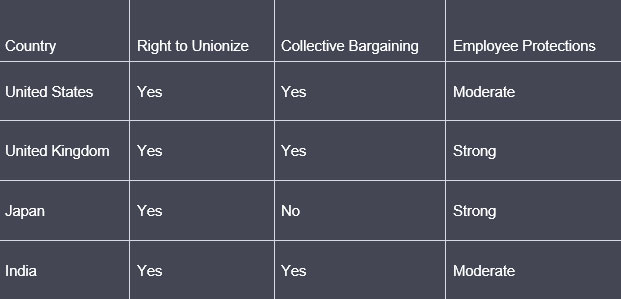“Labor relations” often conjure images of union strikes, collective bargaining, and heated negotiations. However, labor relations is a multifaceted discipline beyond the surface-level drama. It is a field that has evolved, adapting to societal changes, economic shifts, and technological advancements.
In essence, labor relations is the study and practice of managing unionized employment situations. In these settings, Human Resource Management (HRM) professionals must negotiate with unions representing employees to arrive at a collective agreement. This agreement sets the terms and conditions of employees’ work lives, including wages, work hours, and benefits to job security and working conditions.
Labor relations matter because they are a critical component of organizational success. Companies with strong labor relations often report higher levels of employee satisfaction, which can lead to increased productivity. On the other hand, poor labor relations can result in low morale, strikes, and even legal repercussions.
Labor relations also have a societal impact. They influence the balance of power between employers and employees, affecting income inequality, social justice, and quality of life.
Labor relations have become increasingly complex in the modern era due to globalization, the gig economy, and rapid technological changes. These factors have led to new forms of employment contracts and unconventional work arrangements, challenging the traditional paradigms of labor relations.
So, when we talk about labor relations, we are not just discussing a subset of HRM; we are delving into a dynamic field that has far-reaching implications for organizations and society. It is a subject that demands our attention, whether we are business leaders, HR professionals, or even everyday employees.
What is Labor Relations in HR?
In the field of labor relations, the Human Resources department is the lynchpin that holds the organization and its workforce together. Besides mere administrators, HR professionals are the architects of a balanced work environment. They protect the company’s interests and employees’ rights, creating a harmonious atmosphere conducive to productivity.
One of the most critical tasks for HR in the realm of labor relations is to facilitate effective communication between management and employees. This involves not only resolving disputes but also preventing them. By keeping an open dialogue channel, HR helps build trust, a crucial element in any labor relationship.
A recent survey shows approximately 30% of HR tasks are dedicated to labor relations. This includes contract negotiations, grievance handling, and employee engagement programs.
In an era where employee well-being is not just a perk but a competitive advantage, the role of HR in labor relations is more vital than ever. They are the ones who ensure that labor laws are adhered to, that collective bargaining is fair, and that conflicts when they arise, are resolved in a manner that is just for all parties involved.
To sum up, the HR perspective on labor relations is multifaceted. It is not just about rules and regulations but also about fostering a culture where everyone feels heard, respected, and valued. This balanced approach makes HR indispensable in the complex ecosystem of labor relations.
The Legal Framework of Labor Relations
Regarding labor relations, the legal framework is the backbone that holds everything together. It’s not just a set of rules but a dynamic structure that evolves with societal norms and economic conditions. In the United States, for instance, the National Labor Relations Act (NLRA) serves as the cornerstone, granting employees the right to form unions and engage in collective bargaining. But that’s just the tip of the iceberg.

While the NLRA is a federal law, states have their own set of labor laws that can either complement or complicate matters. For example, “right-to-work” states in the U.S. make it illegal for union membership to be a condition of employment, which can significantly impact labor relations strategies.
In Europe, labor laws are generally more employee-centric. The United Kingdom’s Employment Rights Act and Germany’s Works Constitution Act are examples of laws that provide robust protections for employees. These laws not only govern how unions operate but also lay down rules for employer-employee interactions, including dispute resolution mechanisms.
Understanding the legal framework is crucial for HR professionals. It informs every decision, from contract negotiations to dispute resolutions. Ignorance isn’t just risky; it’s costly. Legal missteps can result in hefty fines, not to mention the reputational damage that can last for years.
So, what’s the takeaway? The legal landscape of labor relations is complex but navigable. HR professionals must be well-versed in both federal and state and international laws when operating globally. It’s a tall order, but one that comes with the territory when you’re in the business of managing human capital.
Collective Bargaining – The Heart of Labor Relations
Collective bargaining is often considered the cornerstone of labor relations. It’s the process where employers and employees, usually represented by a union, come together to negotiate terms of employment. The terms range from wages and benefits to work hours and safety protocols.
The Anatomy of Collective Bargaining
Collective bargaining is not a one-size-fits-all process; it’s more like a dance where both parties must be in sync. Typically, it starts with the union presenting a list of demands. The employer then reviews these demands, and negotiations commence. It’s a back-and-forth dialogue that requires patience, understanding, and a willingness to compromise.
The Phases of Negotiation
- Preparation – Both parties gather data, assess their needs, and set objectives.
- Initial Proposals – Formal documents are exchanged, outlining each party’s expectations.
- Negotiation – The actual dialogue takes place, often involving multiple rounds.
- Agreement or Impasse – A mutual agreement is reached, or the parties come to an impasse, leading to further actions like mediation.
Why It’s the Heart of Labor Relations
Collective bargaining is pivotal because it sets the stage for a harmonious work environment. When both employers and employees feel heard and respected, it fosters a culture of mutual respect. This, in turn, can lead to increased productivity, lower turnover rates, and a more engaged workforce.
The Power of Data in Collective Bargaining
In today’s digital age, data analytics plays a significant role in shaping collective bargaining outcomes. Employers and unions use data to strengthen their positions, whether it’s salary benchmarks, industry standards, or employee satisfaction surveys.
Conflict Resolution Strategies in HR
Conflict is an inevitable part of any organization, and the stakes are often high regarding labor relations. The role of Human Resources in navigating these choppy waters cannot be overstated. But how exactly does HR go about resolving conflicts between labor and management? Let’s delve into some proven strategies.
- Mediation: One of the most common approaches is mediation, a neutral third-party intervention to facilitate a conversation between conflicting parties. Mediation is often preferred for its less adversarial nature, allowing both sides to agree mutually. The mediator’s role is to help the parties communicate effectively, identify the issues at stake, and explore possible solutions.
- Arbitration: When mediation fails or is not an option, arbitration steps in. Unlike mediation, the arbitrator has the authority to make a binding decision, which both parties must adhere to. Due to its finality, it’s a more formal process and is generally considered a last resort. The arbitrator will hear both sides’ arguments and then issue a decision, which is usually legally binding.
- Open-Door Policy: An open-door policy encourages employees to bring their concerns directly to management or HR without fear of reprisal. This proactive approach can often nip conflicts in the bud before they escalate. Employees should feel comfortable coming forward with any issues, knowing they will be heard and taken seriously.
- The Importance of Training: Training programs aimed at conflict resolution can equip HR professionals with the skills to handle disputes effectively. These programs often cover negotiation techniques, communication skills, and legal aspects of labor relations. HR professionals need to understand the different types of conflict, identify the root causes of conflict, and develop strategies for resolving conflict effectively.
Key Takeaways:
Mediation is often the first step in conflict resolution.
Arbitration is a more formal, binding process.
An open-door policy can prevent conflicts from escalating.
Training programs can equip HR professionals with essential skills.
By adopting a multi-faceted approach to conflict resolution, HR departments can resolve disputes and foster a more harmonious workplace. After all, a peaceful work environment benefits labor and management, driving productivity and job satisfaction.
Measuring Success in Labor Relations – The Metrics That Matter
Key Performance Indicators, or KPIs, are quantifiable measures used to evaluate the success of an organization’s labor relations efforts. They offer a snapshot of current affairs, allowing for real-time adjustments and long-term planning.
Types of Labor Relations Metrics
Employee Turnover Rate – A high turnover rate could indicate employee dissatisfaction, affecting labor relations negatively.
Absenteeism Rate – Frequent absences indicate a disengaged workforce and may require immediate attention.
Dispute Resolution Time – The time taken to resolve labor disputes can indicate the efficiency of your labor relations strategies.
Employee Engagement Score – This metric gauges employees’ emotional commitment and enthusiasm, directly impacting labor relations.
Union-Management Relationship Score – A specialized metric often used in unionized environments to measure the health of the relationship between management and labor unions.
The Dashboard Approach
Imagine a real-time dashboard displaying all these metrics, offering a panoramic view of your labor relations landscape. This isn’t just a pipe dream; many HR software solutions offer this feature, making it easier to keep your finger on the pulse of your organization’s labor relations.
Interpreting the Data
Data is only as good as the insights it provides. Therefore, HR professionals must collect and interpret these metrics to make informed decisions. For example, a sudden spike in absenteeism might warrant an immediate investigation into workplace conditions.
Labor relations metrics are indispensable tools for any HR professional aiming to foster a harmonious work environment. They provide the data-driven insights needed to navigate the complexities of labor relations, ensuring that both employees and employers can thrive.
Crafting Your Blueprint for Labor Relations Excellence
A well-thought-out action plan can navigate the complex labor relations landscape effectively. Any organization can foster a harmonious work environment that benefits both employers and employees by following these steps:
- Assess the current state of labor relations within your organization. Conduct surveys, interviews, and focus groups to gather insights from employees at all levels. This will serve as your baseline data for measuring improvements.
- Identify key stakeholders in labor relations within your organization. These could be union leaders, HR professionals, or even influential employees. Engage them early in the process to ensure their buy-in.
- Set clear objectives for your labor relations strategy. Whether you aim to reduce labor disputes, improve employee satisfaction, or enhance productivity, having clear objectives will guide your actions.
- Develop a communication plan that includes regular updates, town hall meetings, and an open-door policy for grievances. Effective communication is the cornerstone of any successful labor relations strategy.
- Implement conflict resolution mechanisms like an internal mediation team or third-party arbitration services.
- Monitor the effectiveness of your plan and make adjustments as needed. Use KPIs to gauge success, such as the number of labor disputes, employee satisfaction ratings, and productivity levels.
- Celebrate milestones, no matter how small, to boost morale and encourage continued cooperation among all parties involved.
In addition to the steps outlined above, you can improve labor relations in your organization by being transparent and honest with employees, listening to employee concerns and addressing them promptly, being fair and consistent in your treatment of employees, providing employees with opportunities for growth and development, and creating a positive work environment where employees feel valued and respected. Following these tips can create a harmonious work environment that benefits everyone involved.
Here are some additional tips for improving labor relations:
- Be proactive in addressing potential problems. Don’t wait for a problem to arise before taking action.
- Be willing to compromise. Both sides need to be willing to give and take to resolve.
- Be respectful of each other’s opinions. Even if you don’t agree with someone, you can still respect their right to opinion.
- Be willing to listen. One of the best ways to resolve a conflict is to listen to each other’s point of view.
- Be willing to change. Sometimes, changing your behavior is the best way to resolve a conflict.
- Be patient. It takes time to build trust and resolve conflict. Be patient and don’t give up.
These tips can create a positive and productive work environment for everyone involved.




